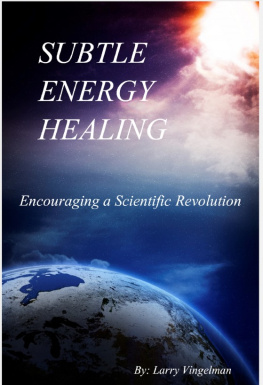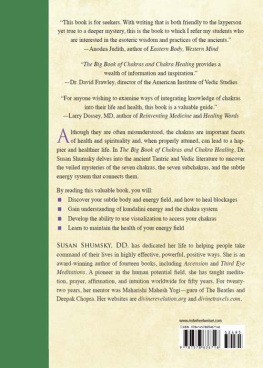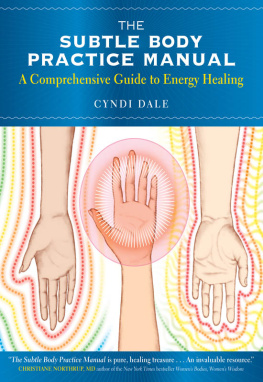Subtle Energy Healing Encouraging a ScientificRevolution
By: Larry Vingelman
Subtle Energy, Inc.
This book is copyrighted. Apart from fairdealing for the purposes of private study, research, criticism, orreview, as permitted under the Copyright Act, no part may bereproduced without the express written permission of thepublishers.
All rights reserved.
This book describes ongoing research in areasof physics, biology, and our latest understanding of the influencesubtle energies have on the human condition. It is not intended inany way to recommend any medical treatment or prescribe or treatany illness or medical condition. The information contained in thisbook refer to technologies, which are experimental and in manycases, not approved or recommended for all applications to healthcare. This information is in no way to be considered medicaladvice, or a substitute for a consultation with a licensedphysician. All decisions regarding health and medicine should bemade in a consultation with ones licensed physician or medicaladvisor.
In addition, no person or corporation shouldmake any investment decisions based on the commercialization ofsubtle energies as described in this book without first consultinga licensed investment advisor.
Larry Vingelman, and Subtle Energy, Inc. arenot affiliated with any state or government lottery. The author andpublisher make no warranty of any kind, expressed or implied,including but not limited to implied warranties. In no event shallauthor or publisher be liable for any damages for gambling lossesor other pecuniary loss even if author or publisher have beenadvised of the possibility of such damages.
Also See:
http://www.SubtleEnergyHealing.com
http://www.facebook.com/SubtleEnergyInc
Table of Contents
STARGATE
Chapter1 Subtle Energy and the Ages of Man
Today, as in ancient times, interest insubtle energy abounds. In the Indian tradition, subtle energy iscalled Prana, a vital force central to Vedic science. In China, itis called chi and is used in healing and other high arts. InAustralia, the Aborigines believed it came from the Sun and flowedalong special paths in the ground they called songlines.According to scholars, they would walk for hundreds of miles alongthese lines in rituals to energize them so that they could infusethe life force into their crops. There were similar traditionskept by the Druids in England, and there were the dragon lines inChina. Flowing subtle energy is called mana by the Polynesiansand orendo by the Iroquois. The Great Sioux Nation called thislife-generating force wakonda, while in North Africa it wascalled Baraka. The ancient Greeks called it pneuma and believedit was related to the spirit or soul in a similar fashion as statedin Vedic texts.
It seems as if wherever belief in subtleenergy existed, we find large megalithic sites. Hinting at acelestial source, these structures seem to have been built tocontrol and channel this energy. In a similar way, the traditionalhealers in these cultures Chinese doctors, Hindu yogis,Polynesian shamans, and Sioux medicine men practiced controllingand balancing subtle energy for their patients (seeSwanson video). Today, we understand subtle energy to bea technology, a tool to be studied and used to aid a healthier,more productive life. It has come to be thought of as the fifthforce of nature, taking its place along with gravity,electromagnetism, and the weak and strong nuclear forces.
A historical perspective on subtle energygives us a better understanding of the dynamics of this force ofnature. This perspective shows the enormity of the wondrous effectsthis force has had on mankind over the millennia. Many scholars nowagree that all ancient civilizations had knowledge of subtleenergy. It is a part of their myths and folklore. When these mythsare examined, many healing and spiritual benefits become apparent.However, the most insightful information concerning the nature ofsubtle energy is told in the great myths of the ages of man.
According to various cultural myths, the agesof man refer to the stages of human existence on Earth. Each of theancient civilizations seems to have experienced these stages asvarious states of human awareness. The most glorified ages inhistory tend to accompany a presence of higher states ofconsciousness, while the bleaker ages reflect proportionally lowerstates of awareness. Throughout the ages of man, knowledge ofsubtle energy and a civilizations ability to use it werefacilitating factors. Remarkably, although these civilizations wereseparated both temporally and geographically, all assigned fourdistinct stages, referred to as the ages of man.
Historically, subtle energy theorists havequestioned the facilitating nature of this primordial force. Forexample, why does it seem that subtle energy affected ancientpeople more than modern people? What causes subtle energy to waxand wane, creating these ages? What causes the increased density ofsubtle energy over long periods of time? What is the current stateof subtle energy technology, and does it hint at human abilitiesbeyond what we ever dreamed possible? Can subtle energy show us thefurthest reaches of human potential? Does it validate alternativemedicine? Will the current revival of subtle energy technology giveus a sense of optimism, inspiring us to heal ourselves, our lovedones, our communities, and the world?
Hamlets Mill
If knowledge of subtle energy is timeless, we should see itsnarrative played out in the cultural myths of the ancients. So, itis not surprising that references to subtle energy and its effecton human consciousness are found in over thirty ancient cultures,as documented by historians Giorgio de Santillana and Hertha vonDechend. Their enlightening work, Hamlet'sMill: An Essay of Myth and the Frame of Time describesin detail worldwide myths and folklore dealing with the ages of manand the effect that an invisible energy has had on humanconsciousness. Walter Cruttenden, author of the Lost Star ,said that, When these highly respected scholars completed HamletsMill in 1969, the worlds of archaeology and anthropology wereforever changed. The idea of higher ages existing in the pastappears to be woven into most cultural traditions, giving credenceto their effect on history.
In Hamlets Mill, Santillana and von Dechenddemonstrate that awareness of subtle energy was not an isolatedincident. For example, the Norse, Celtic, Lakota, and Persians aredescribed in detail. The most developed, however, in addition tothe Vedic Ages (called Yugacycles ), are the Greeks, Egyptians, Mayans, andHopi.
Hamlets Mill proposes that, "Our ancestorsof the high and far-off times were endowed with minds whollycomparable to ours, and were capable of rational processesalwaysgiven the means at hand. Santillana and von Deschend go on to saythat these ancient civilizations were particularly fascinated byastronomical observations and that they made many discoveries. Oneof the most important was the precession of the Earths axis,called the precession of the equinoxes. This is known as thecircular shift in the Earths axis of rotation (see graphic above).A similar action is exhibited in the wobble of a spinning top. Inthe view of Santillana and von Dechend, precession was discoveredlong before the accepted date of the Greek discovery.
In addition, these civilizations believedthat the world passed through cycles or ages of approximately24,000 years based on this circular motion or precession. Thesemyths also discuss other astronomical knowledge, enhancing beliefin the ages of man, as well as the changes in human consciousnessthey induce. In another chapter, we will explore WalterCruttendens idea that the precession is solar system based and notEarth centric. From his point of view, the solar systemmoves into and out of more or less dense subtle energyfields, causing changes in consciousness during the ages ofman.
Next page








